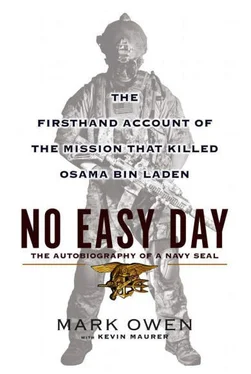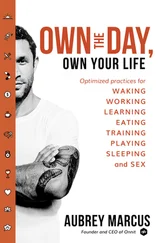“Once outer security is dropped off, the helo will pick up and hover above A1 and the remaining assaulters are going to rope onto the roof, make their way down onto the third-floor balcony, and clear the third deck.”
If the intelligence was correct and everything went according to plan, that was the team that was most likely to encounter Bin Laden first.
The rest of the brief Jay and Mike spent going over the load plan. Finally they designated several “pro” words for the operation. Pro words are one-word messages that relay information in an efficient manner. This kept radio traffic to a minimum and made passing information more reliable. On this mission, we chose pro words with a Native American theme.
“UBL is Geronimo,” Jay said.
The mission briefing took about an hour, and when we were done Mike and Jay left.
“Now you guys shoot holes in this,” Mike said. “Jay and I have been looking at this for several weeks now. You guys got it yesterday. Take some time and really get into the weeds.”
We tried never to fall in love with a plan, because that breeds complacency.
The first thing we tried to do was find an alternate way to approach the target. No one wanted to fly to the X. We’d given up doing that years ago. We were more comfortable being dropped off and patrolling to the compound. Our tactics had evolved over the years into being as sneaky as we could so we could keep the element of surprise until the very last second.
The reconnaissance and sniper teams studied satellite images, trying to find landing zones within four to six kilometers of the target, but none of the routes seemed to work. The compound was in a residential area. All of the landing zones were either too close to urban areas or we’d have to walk down city streets. The risks of getting compromised during our infil were too high. In the end, flying to the X was the lesser of two evils. It would be loud, but it would be fast. We couldn’t risk being compromised during the foot patrol.
Huddled in separate corners of the operations center, the teams got together individually to plan their part. Beyond our personal gear, we started to divide up our team gear list—a ladder, a sledgehammer, and explosives.
“I’ll need the ladder to climb the carport,” the sniper said. The collapsible ladder was heavy and burdensome. “Mike said he’d carry it on his back during the fast-rope so I can provide better security.”
We positioned two snipers, one in each door of Chalk One, to cover us as we roped into the compound. We didn’t need someone walking into the compound with an AK-47 and shooting us as we slid down the rope.
“Since Will isn’t here to argue, he gets the sledge,” I said with a smirk. “I’ll carry two breaching charges and a set of bolt cutters.”
A breaching charge was a two-inch-thick strip of explosives. The charge was about twelve inches long with a strip of adhesive that ran along its spine so we could stick it to the door. Once initiated, it would explode in about three seconds and usually tear a door open by cutting through the locking mechanism.
The goal of each team was to be self-sufficient. The last thing anybody wanted was to have to call another team over to help because they didn’t have the right equipment.
A woman from the National Geospatial-Intelligence Agency, a blonde in her early thirties, took care of the maps and satellite images for us. She provided any detail—big or small.
Kneeling down to look at the mock-up, I studied the door leading into the guesthouse.
“Hey, are these doors on C1 inward or outward opening?” I asked her.
She was back in a few minutes with the answer.
“Double metal door,” she said. “Opens outwards.”
It was like that all week. If we had a question, they had the answer, including where the Pacer walked, who else lived on the compound, which gates were locked or unlocked, and even where they frequently parked their cars. They had a huge number of images from drones and satellites, and there wasn’t much they didn’t know about the outside environment of the compound.
______
In Washington, President Obama and his advisors were still discussing different options. The president still had not signed off on the ground-assault option. All we had been authorized to do up to now was to start planning and conduct rehearsals. The White House was still considering an Air Force option, a massive air strike using B-2 Spirit bombers to level the house.
Defense Secretary Robert Gates supported the air strike because it kept American ground forces out of Pakistan, which made the mission less like an invasion of the country’s sovereignty.
The United States didn’t have a great track record when it came to commando raids like the one we were planning. Since Operation Eagle Claw, there was a lot of risk in putting troops in harm’s way in a sovereign country.
During Eagle Claw, one of six helicopters flying to a desert staging base in Iran before the raid hit a fierce sand cloud and crashed into an MC-130E containing fuel. The fire destroyed both aircraft and killed eight servicemen. The mission, one of the first operations conducted by Delta Force, was aborted. Eagle Claw was a disaster and contributed to Carter losing his reelection campaign.
The air-strike option required thirty-two two-thousand-pound smart bombs. The barrage would last for a full minute and a half and the crater would penetrate at least thirty feet into the earth in case the compound had a bunker system. The possibility for collateral damage was high, and the possibility of finding identifiable remains after that kind of destruction was low.
If we were going to conduct this mission either with an air strike or raid, they wanted proof it was Bin Laden. The assault was risky, but the air strike added additional complications.
______
A few days after we arrived in North Carolina, we saw the Pacer for the first time.
Standing around the computer screen, we watched drone footage of the compound. The feed was black-and-white with little detail. I could make out the main building and the courtyard that took up the northeastern part of the compound.
After a few seconds, I saw the Pacer enter the frame. From the video feed, he looked like an ant. There was no way we could make out his face or even how tall he was. But we could see him walk out of the north door and start pacing in an oval clockwise around the courtyard. A makeshift awning was rigged up to cover him, but it only shaded part of the garden.
“He does this for hours,” one of the agency analysts said. “I’ve seen him walk by guys doing work, but he never helps. He just paces.”
Sometimes, he walked with a female or a child. None of them stopped to do any work. When a veterinarian came to treat the cow that lived in the courtyard, they moved it to another courtyard for treatment.
“We believe the reason they moved the cow is they don’t want anyone to see that side of the compound,” the analyst said. “It’s circumstantial, but it looks like they are hiding someone. Hey, take a look at this.”
Clicking to another day’s feed, we could see the compound and then, from the right side of the screen, a Pakistani helicopter flew over.
“Where did that come from?” I said.
“A PakMil Huey,” the analyst said. “Not sure where it came from, but it was leaving the military academy.”
We all stared at the screen, waiting to see if anyone in the compound reacted. We didn’t see the Pacer sprint to a car and run. Instantly, we all thought the same thing. This meant he was accustomed to hearing helicopters.
“We might actually be able to get on the deck before they really figure out what is going on,” Charlie said.
Читать дальше












